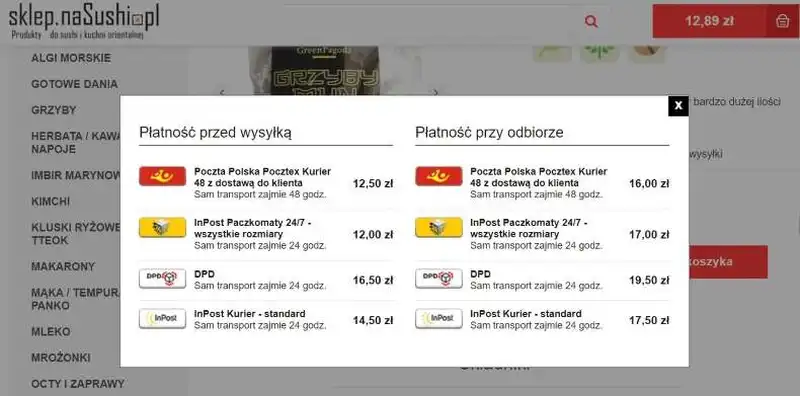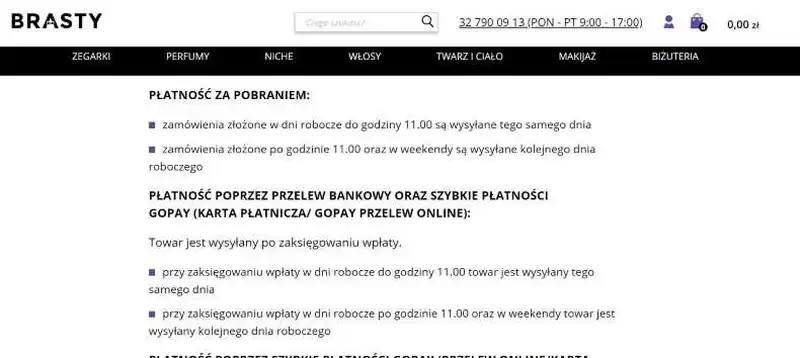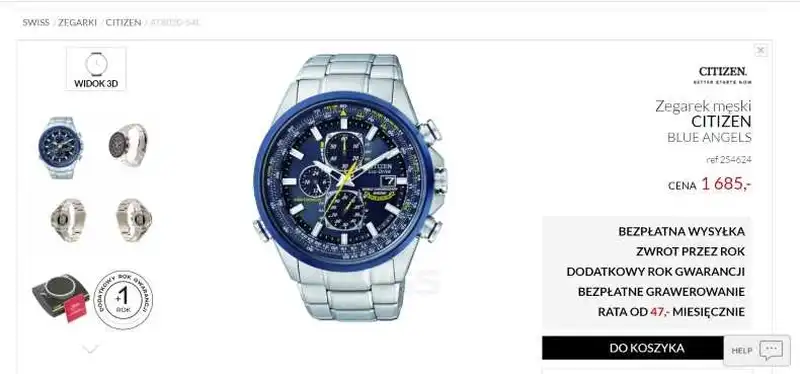Everybody can agree that these pieces of information are significant to E-Commerce customers.
They are so important that they can influence the purchasing decision and convince customers to finalize or abandon the purchase at the last moment.
Customers want to know what the order fulfillment process looks like in practice.
Designing information about the shipping of products, pick-up methods, and delivery terms is crucial.
A question naturally comes to mind, or more precisely, many questions about design patterns, recommended solutions, issues that can't be omitted, or finally, experiences of E-Commerce customers.
By reading the following article, you can find out everything you need to know about the user experience of order fulfillment, particularly the methods of communication and presentation of crucial information.
Such as information about shipping, pick-up methods, and delivery of an order.
Why is information about order fulfillment so important?
Time is money. This maxim is well-known and understood not only by businesspeople. Online store customers have very similar expectations regarding the time of order fulfillment.
They treat it as an important variable. Same-day delivery! — that's what they expect. However, that's not the only thing; the delivery should also be free.

They want to know whether it will be like that before they start to search for any products. Or at least when they reach the product page of a given item.
How the online store communicates these elements of its offer (e.g., time of order fulfillment) largely determines how it is seen and evaluated, what emotions it arouses, and what behaviors and reactions it causes.
Is this an exaggeration? Unfortunately, no.
This trend, spearheaded by big E-Commerce players like Amazon, quickly became widespread. Today these kinds of expectations are not only placed on global brands but also local online stores with weaker market positions.
The fulfillment of the customer order — according to the above expectation — should start just after the finalization of the transaction. Customers want to be informed immediately about the course of this process.
In particular, this applies to constant and repetitive elements of the order fulfillment process. We are thinking about passing information to the warehouse, order picking, preparing the package, handing it over to the delivery company, etc.
These messages are valuable information that counteracts undesirable reactions that can occur in a situation of information deficit.
Why is an up-to-date notification of online store customers about the course of order fulfillment essential?

Because shopping in online stores, despite its popularity, a multitude of experiences, and trust in it, still looks a bit like a great unknown.
A lack of reaction from the store, from the customer's perspective, can indicate:
- System error — the order was not successfully placed
- Correct system operation, but according to incomprehensible, uncertain logic
- Possibility of fraud, the store doesn't really work.
In other words, uninformed customers are stressed, anxious, and distrustful. It's not a desirable state for any side. The online store would lose credibility and customers, and the latter would not want to repeat purchases in the store that resembles a black box.
Customers, especially in the situation of "payment in advance," want to know what is going on with their order — whether it is fulfilled in line with their assumptions and habits.
Cognitive control over the process should be supported by appropriately designed information on:
- Terms of shipping, pick up, and delivery
- A course of the shipping, pick up, and delivery.
Information regarding terms of order fulfillment should be displayed on the home page, category pages, and product pages and consequently repeated on the order summary and checkout pages.
In turn, information on the course of shipping, pick up, and delivery should be offered in the customer panel, in e-mails, and in the form of notifications in mobile applications and text messages.
The process of order fulfillment should be communicated and what's even more important, received as:
- Logical
- Purposeful
- Phased (structured)
- Predictable
- Understandable
- Familiar
- Controlled by the customer.
How to inform a customer about the shipping, pick up, and delivery of an order?
Shipping, delivery, and pick up in the online store or indicated address are perhaps the three most troubling issues for customers.
When? How quickly will the order arrive? How to pick it up? And this brings us to the first problem, dilemma, namely the method of presenting the estimated delivery time.

Is it better to communicate the order fulfillment time with the number of days, or maybe it's more effective to do it with a specific date?
According to the researchers from the Nielsen Norman Group, who conducted thorough studies on this topic, it's definitely more effective to indicate a particular date, day of the week, and time frame in which customers can expect the delivery person or the delivery to the pick-up point.
From the customers' perspective, answers to the following questions are crucial:
- When will the order be delivered?
- What guarantees it will be delivered on the indicated date?
- Which delivery company will be responsible for the delivery?
- Can the given delivery company be trusted?
- What were my experiences with the given delivery company?
- Can I pick the delivery company?
These dilemmas can't be omitted or underestimated because they affect the purchasing decision.
Punctual and trouble-free delivery is a top priority for E-Commerce customers. Sometimes it's even more critical than the price, which doesn't always compensate for a long delivery time or inconvenient form of pick up.
That's why answers to the above questions should be a permanent element of every online store. It's not just a collection of information but also a communication process.
In this sense, the online store interface (UI) should be linked to the communication process and maintaining contact with customers and delivering them essential information, which allows them to control the process cognitively and will enable them to stay calm.
It's worth remembering that providing the number of days instead of a specific date requires customers to trigger cognitive processes which they do not want to activate. The cost of interaction with such information is simply too high.
This method of determining time is not only cognitively taxing but also unfriendly regarding the purchasing situation, which is not always comfortable.
The number of distractors (distracting stimuli) during purchase is significant. Hence you should offer information in the most customer-friendly way.
Customers don't like being forced to make calculations. They want to know the time context immediately.
The date and the specific day of the week provide customers with a concrete reference point.
For example, related to their rhythm, plans, responsibilities, and professional and personal circumstances.

A message stating: "The package will be delivered in 4 days" in reality doesn't say much. In contrast, a message like this: "The package will be delivered on Friday, June 21, 2023," is a piece of information that immediately allows customers to discern whether the date is problematic, ideal, or neutral. Whether it involves some kind of limitations.
A specific date is significant in the case of the following:
- B2B orders, where the punctuality of the order can affect processes, quality, efficiency, and reliability; in other words, it can mean a high risk of loss for the company making the purchase
- Perishable products
- Products that are dangerous or require special transportation and protection.
The availability of information about delivery costs, date of delivery, pick-up points, and estimated hours of order delivery is crucial.
Fast order fulfillment can't just be an advertising slogan, but it should be considered as such by online store customers. To achieve that, the customer needs to be able to learn about this information.
As researchers from NN Group aptly observed, any concealment of crucial information is undesirable and not recommended. It's not only viewed as an unfair practice or ethically questionable but also as a practice that can undermine the time and energy invested.
At the end of the day, customers don't look for products only to find out that the cost, delivery method, or date is highly unattractive to them.
The results of other studies are worth keeping in mind as well. According to researchers from Baymard Institute (Delivery & Shipping Methods), too expensive and purposefully communicated at the final stages of order placement costs of delivery are responsible for as much as 60% of shopping cart abandonment.
Thus, information on delivery costs and methods should be clear, specific, and displayed on the home page of the store and product page and repeated at every stage of the E-Commerce path to purchase.
It's also worth remembering that this information should precede the entering of contact details.
In other words, it shouldn't be available after logging in or creating a new account. It should be accessible for unregistered customers that visit the store as guests.
The experience that comes from the interaction with the product page or order summary/checkout, especially the availability of crucial information, directly influences the customers' satisfaction. It's essential for a positive user experience in the purchasing process in the store.
That's why the main goal of the store should be to offer data that is:
- Complete
- Regularly updated
- Specific, unambiguous, and without conditions
- Consistent
- Simultaneously total and partial (e.g., delivery costs, product costs including taxes)
- Multifaceted (it should include the cost, date, delivery method, and pick-up point).
A good design pattern is to inform customers immediately about all order delays. It's particularly significant during periods when purchases in online stores are increased (e.g., the holiday season).
If, for various reasons, the package can't be delivered on time or its delivery will take longer than standard 24, 48, or 72 hours, customers should be aware of this fact even when the problem has occurred unexpectedly because of unforeseen events or unrelated to procedures and store standards.

It's worth keeping in mind that an informed customer is much more understanding than an unpleasantly surprised customer. Hence customers should be notified in advance or in real time about changes in order fulfillment.
In the case of order pick up — at home or in a stationary store — it's good to offer an option to add comments or special requests.
For instance, regarding consent to leave the package with neighbors or at the reception. The ability to choose preferred hours of delivery also significantly improves customer experience.
Designing information about shipping, pick up, and delivery. Summary
- Designing information on shipping, pick up, and terms of delivery is crucial from the perspective of ensuring a positive user experience.
- Customers should be notified about the course of order fulfillment just after the finalization of the transaction.
- Shopping in online stores is still risky for E-Commerce customers, and it's a source of anxiety that increases as the information deficit prolongs.
- Online store customers expect to be able to control the order fulfillment process cognitively; hence this need should be supported with proper design solutions.
- It's vital to offer information about shipping terms, pick up, and delivery, as well as about the course of the shipping, pick up, and delivery.
- The order fulfillment process should be seen as familiar, purposeful, and phased and have clear, understandable logic.
- A more effective method is to specify precisely the date, day of the week, and the time frame in which the customer can expect the delivery person.
- Punctual and trouble-free delivery is a top priority for E-Commerce customers.
- Providing customers with the necessary information that allows them to cognitively control the process (making an online purchase requires it) is a crucial task of the store in this dimension of its operation.
- All information (about the shipping, pick up, and delivery) should be transparent, displayed without conditions, and accessible in different places and at various stages of the purchasing process.
- It should be clear, even obvious, to the customer what order fulfillment means in practice.
- The experience that comes from the interaction with the product page or order summary/checkout directly influences the customers' satisfaction.






